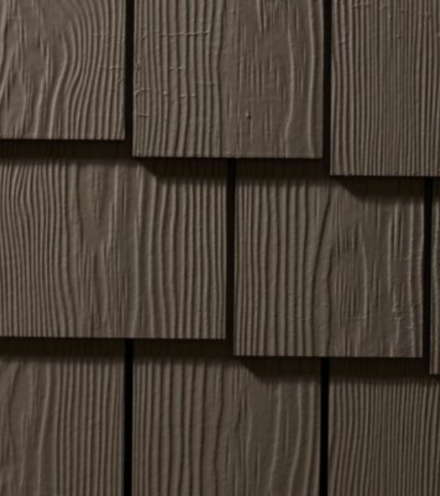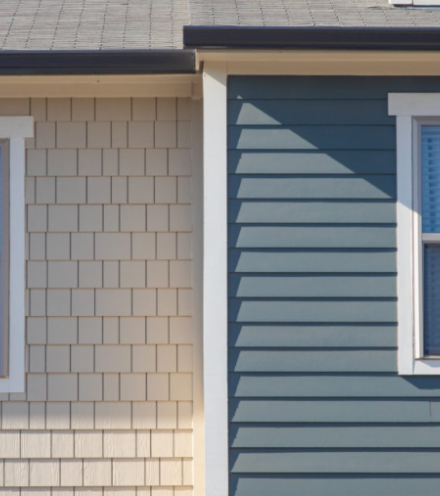Sizing up wood siding and vinyl siding is pretty straightforward. After all, these are two of the oldest and most common material types used for house exteriors. Whether you’re building from the ground up or replacing old siding, it’s important to know what problems to anticipate down the line.
This can help you gauge how much ongoing costs, repair work, and maintenance to expect – as well as when to anticipate the next siding overhaul.

Comparing wood siding with vinyl siding can reveal some issues that you should know about before settling on one of these materials for the exterior. If you’re like most, you’ll probably be interested in avoiding the issues that can come with wood and vinyl – and opting for a better siding alternative instead.
Wood vs. Vinyl Siding: the Good, the Bad and the Ugly
Both wood and vinyl are common choices for exterior siding, and lots of homeowners tend to stick with these materials simply out of familiarity. Unfortunately, both vinyl siding and wood siding have some significant issues – including poor durability and frequent weather damage – that homeowners should be aware of when remodeling. In many cases, switching to a more durable alternative can save homeowners time, money, and energy down the line.
With that said, there are still some advantages that these types of materials offer. If you’re set on choosing one of these materials, then a wood vs. vinyl siding comparison can still be helpful. Get to know the pros and cons of vinyl vs. wood siding to find the best option for your project.
Wood Siding Pros and Cons

Wood siding is a classic choice that has been used for centuries. By far the biggest advantage of wood siding is its authentic charm and aesthetic quality. Natural wood grain patterns can add nice texture to the look of the exterior. Wood siding is fairly diverse in design, as well. Lap, dutch lap, board and batten, shake – these traditional styles give homeowners plenty of styles to consider.
That beauty comes at a cost, however, and wood siding can be one of the most difficult exterior materials to maintain. Because of its natural composition, wood siding is prone to dry rot, moisture damage, and color fading. Homeowners should be prepared to paint or stain their natural wood siding every 3 or 4 years to preserve the original quality.
Other concerns with wood siding include flammability and insect infestation – both of which can put the home at risk. Finding responsibly forested wood can also be tricky, due to sustainability concerns.
Vinyl Siding Pros and Cons
Vinyl siding is often utilized for its affordability, which makes it a good option for first-time homeowners and builders on a budget. When comparing wood to vinyl siding, vinyl also has an advantage in terms of installation, since it’s typically lightweight and easier to install.
Unfortunately, vinyl pales in comparison to wood in terms of aesthetic quality. Since it contains a plastic-based component, vinyl sometimes has a visible sheen that gives it a sub-par appearance, so it lacks the authentic charm of real wood. The plastic composition also creates environmental concerns, as VOCs and other harmful toxins can be released during the production of vinyl siding.
Beyond these issues, vinyl has another big problem: it’s prone to damage outdoors. Humidity and moisture can cause mold and mildew to grow on the slick surfaces of vinyl siding, which can create unsightly buildup that needs to be cleaned regularly. Extreme temperatures can also be problematic – vinyl can warp and buckle in high temps and crack in cold climates.
A Better Solution for the Vinyl vs. Wood Siding Debate
Homeowners will have to seriously weigh the pros and cons when comparing vinyl siding to wood, since both materials have advantages and issues. One thing they certainly have in common is that both wood and vinyl are high-maintenance materials.
A smart way to avoid all of these issues is to switch to a more durable, long-lasting material that has been changing the game when it comes to exterior siding. Crafted in a variety of styles, fiber cement siding outshines wood and vinyl in many ways.

Here are a few of the benefits:
- Better Durability – Fiber cement is made from a unique combination of sand, water, and cellulose fibers for long-lasting strength.
- Easier Installation – Panels with pre-fabricated styles make it easy to install on site.
- Stronger Weather Resistance – Fiber cement is designed to maintain its original allure in all types of weather, which makes it a great choice for use in any region regardless of climate.
- All Aesthetic Styles – Shake, lap, smooth panel, wood grain style – fiber cement can be created in any style for an authentic look that’s easier to maintain.
Select the Better Siding with Allura’s Fiber Cement
Why weigh the pros and cons of vinyl vs. wood siding when there’s a better alternative that performs so much better? Contact Allura today to find a gorgeous selection of fiber cement siding that’s low-maintenance and long lasting!




